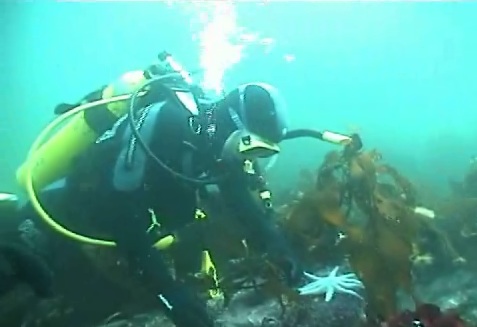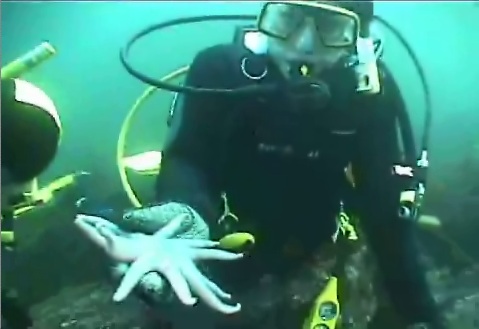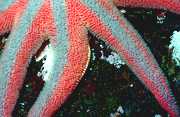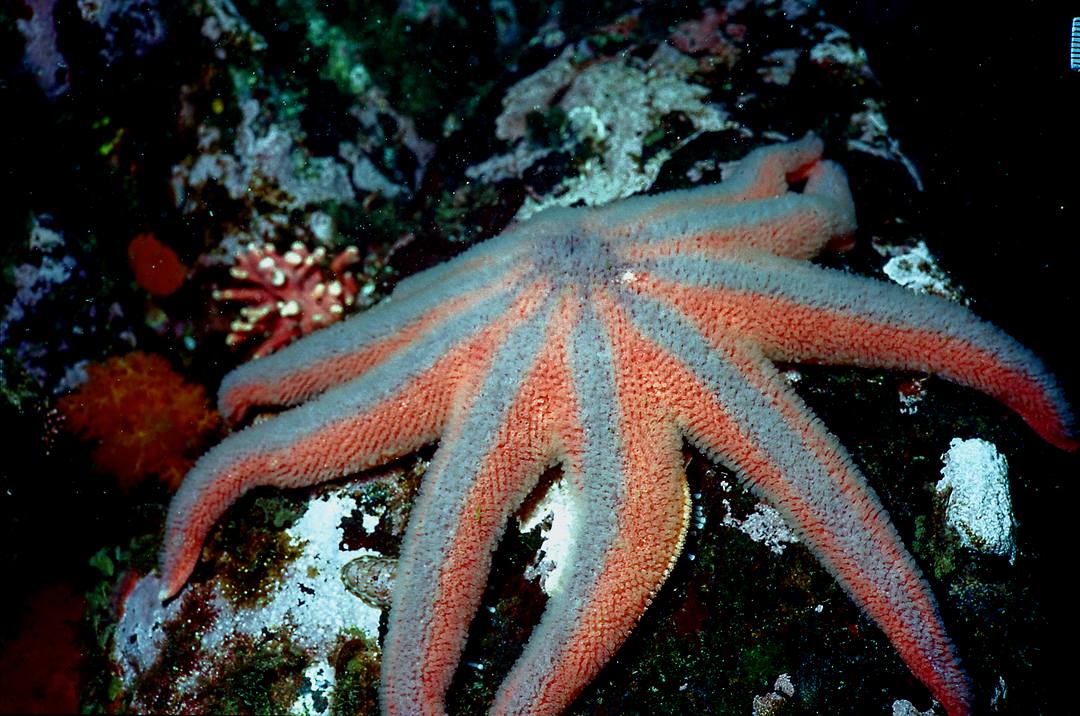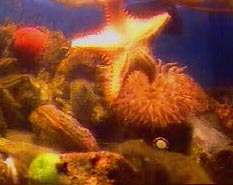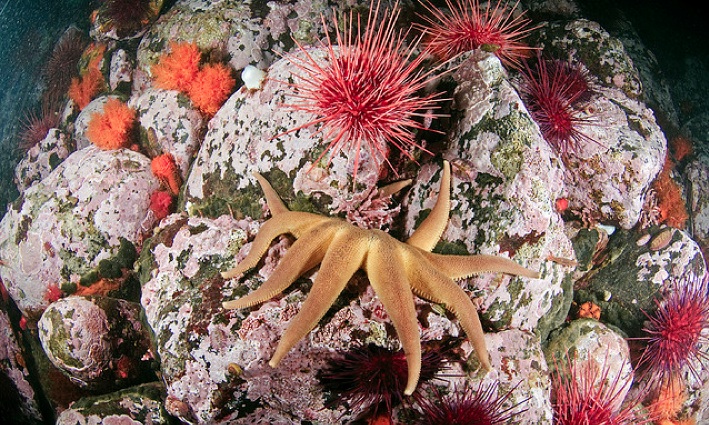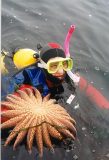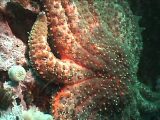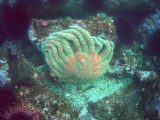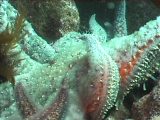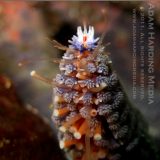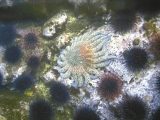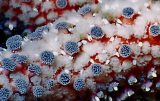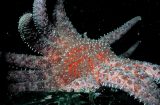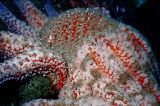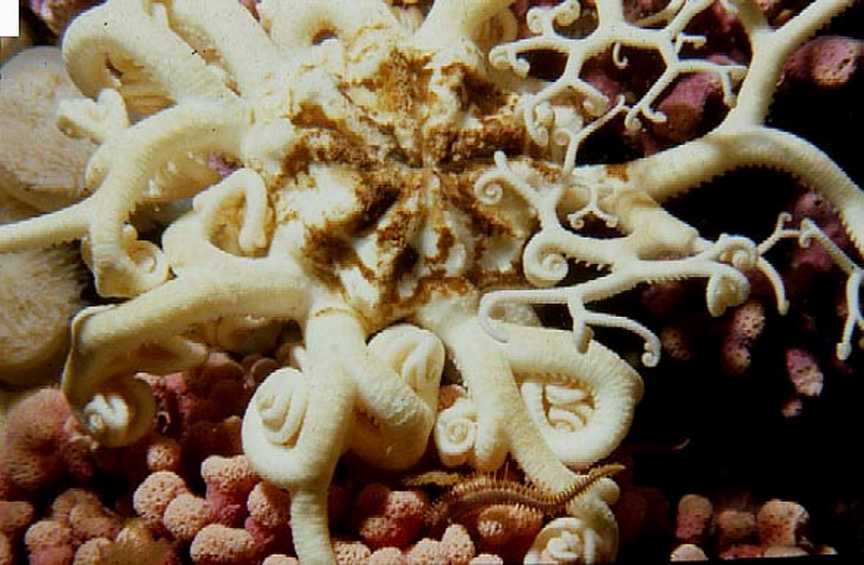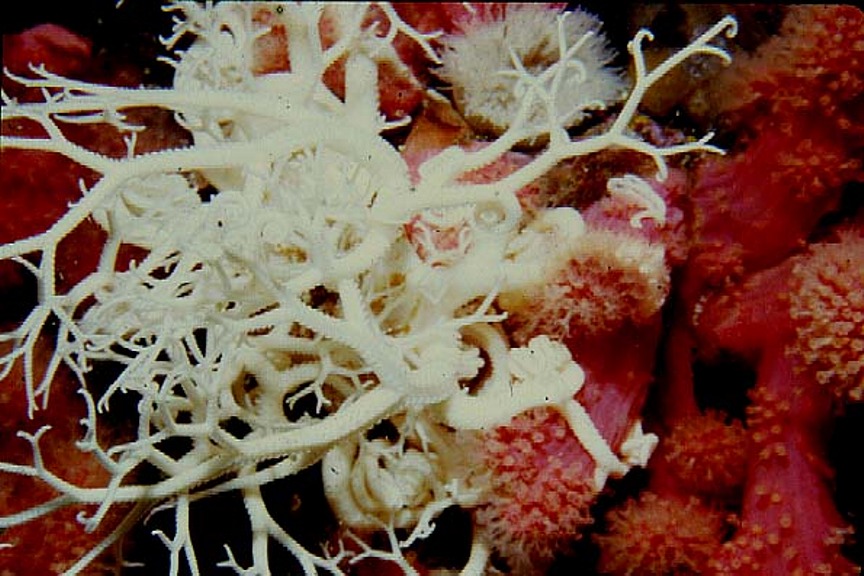This is a frame taken from the video beside. The blue color is because white light does penetrate to a depth of 8 metres, so only the parts of the picture that are illuminated from the video light show the true colors.. Note in the video how objects appear to change color when illuminated, but, they don’t actually do so. In the foreground is a broooding anemone , red with a band of babies at its girth. The pink coral is hydrocoral.
“Invertebrates at Race Rocks” is an introductory piece on a few of the invertebrate phyla. This was one of the first hinted streaming videos done by the Pearson College divers in April 2000. There is a good section on Soalaster Stimpsoni in the film. It was taken by Rowena and Shamsher on a Sony Digital camera, and edited by Hannah and Garry on a G4 Macintosh Computer using iMovie.
Physical Description
It has 8-12 arms, but usually it has 10 arms, which has length is about 23 cm. The diameter about 20 inches (51 cm). And the central disc about &Mac185; of total diameter. It&Mac226;s mouth just below the central disc. And, as the common sea star, it uses its tube feet which under main arms to move.
- A diver finds a Solaster in it’s typical habitat beneath the Pterygophora canopy
- The aboral or top side
- The oral or bottom side Photos by Pearson College Divers.
- The gills show here
- photos by Dr. Armin Svoboda
Global Distribution
This kind of sea star could be found at Bering Sea to Salt Point California (Trinidad Head, Sonoma Country, Kodiak Island and Oregon) and Pacific Northwest (Sunrise Beach and Gig Harbor).
Physical Description
It has 8-12 arms, but usually it has 10 arms, which has length is about 23 cm. The diameter about 20 inches (51 cm). And, as the common sea star, it uses its tube feet which under main arms to move.
Habitat
This sea star is possible to find at rocky bottoms but sometimes in sand or in the lowest zone.
Domain Eukarya
Kingdom Animalia
Phylum Echinodermata
Class Asteroida
Order Spinulosida
Suborder Eugnathina
Family Solasteridae
Genus Solaster
Species stimpsoni
Common Name: Stripped Sun Star, Sun Star, Stimpson’s
Feeding
This animal is a carnivore. It usually feed at sea cucumbers (the most favorite foods), tunicates, lampshells, sea pens, brachiopods, holothurians, sea squirts and nudibranch.
Predator
The predator of this animal is Sunflower Star ( Solaster dawsoni).
Reproduction
It reproduces sexually. It is breeding from February to March. Gametes are discharge into water. The eggs then become larvae and start to metamorphosis for about 40-50 days.
Interesting Thing
It can curl its arms up over its body to take on a spherical shape. This allows it to tumble across the seafloor in the along-shore currents.
References
Alaska Fisheries Science Center, Sun Sea Star Solaster Stimpsoni. Internet
British Columbia Creature Page. Internet
Edmonds Discovery Programs. Internet
Gotshall Daniel (1994) Guide To Marine Invertebrates. California
King Country (1999) Sun Star &Mac246; Solaster Stimpsoni. Internet
Lambert Philip (1965) Sea Star. Vancouver, Canada
Morris Robert, Donald A & Eugene H (1980) Interditial Invertebrates of California. California
Photo Gallery. Internet
Strathmann Megumi (1987) Reproduction And Development of Marine Invertebrates of The Northern Pacific Coast. Friday Harbour Laboratory
Verrill (1880) Solaster Stimpsoni. Internet
Yates Steve (1988) Marine Wildlife. Washington
| Other Members of the Phylum Echinodermata at Race Rocks |
and Image File |
 The Race Rocks taxonomy is a collaborative venture originally started with the Biology and Environmental Systems students of Lester Pearson College UWC. It now also has contributions added by Faculty, Staff, Volunteers and Observers on the remote control webcams. The Race Rocks taxonomy is a collaborative venture originally started with the Biology and Environmental Systems students of Lester Pearson College UWC. It now also has contributions added by Faculty, Staff, Volunteers and Observers on the remote control webcams.
January 2006 Winda (PC year 32) |


